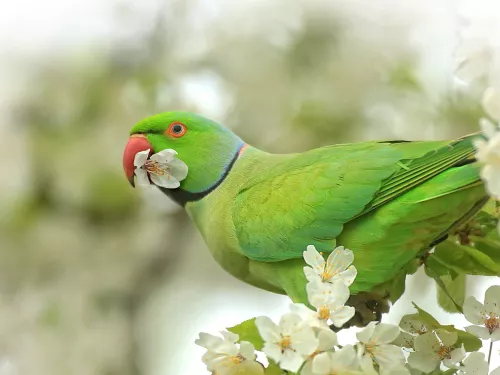Rhododendron leafhopper
An introduced species, the Rhododendron leafhopper is a striking mix of green and red, with a black stripe across its face. It can be found feeding on Rhododendrons (also introduced) in Southern England.
An introduced species, the Rhododendron leafhopper is a striking mix of green and red, with a black stripe across its face. It can be found feeding on Rhododendrons (also introduced) in Southern England.
The brown, oval flower heads of ribwort plantain balance on top of thin, wiry stems; the resulting seed heads provide food for birds in winter. Look for this 'weed' in lawns, fields and grasslands.
The blackbird of the mountains, ring ouzels can be found breeding on upland moors and rocky crags in summer.

The bright green ring-necked parakeet is an escapee and our only naturalised parrot; its success is likely due to warmer winters. It can be seen in the South East.
The ringed plover is a small wader that nests around the coast, flooded gravel pits and reservoirs. It is similar to the little ringed plover, but is a little larger, has an orange bill and legs, and doesn't have a yellow ring around its eye.
The ringlet gets its name from the small rings on the undersides of its wings. These rings show variation in the different forms of this species, even elongating into a teardrop shape.
Risso’s dolphins are mysterious creatures usually only found in deep, offshore waters.
The river lamprey is a primitive, jawless fish, with a round, sucker-mouth which it uses to attach to other fish to feed from them. Adults live in the sea and return to freshwater to spawn.
The silvery roach can be seen gathering in large shoals in lowland ponds, lakes and slow-flowing rivers. It is a member of the carp family and looks very similar to the dace, chub and rudd.
The much-loved robin is a garden favourite and one of our most familiar birds, adorning Christmas cards every year. It is very territorial, however, and will defend its post with surprising ferocity.
Living up to its name, the Robin's pincushion is a red, round, hairy growth that can be seen on wild roses. It is caused by the larvae of a tiny gall wasp that feeds on the host plant, but causes little damage.
The wild rock dove is the ancestor to what is probably our most familiar bird - the feral pigeon, which is often found in large numbers in our towns and cities.